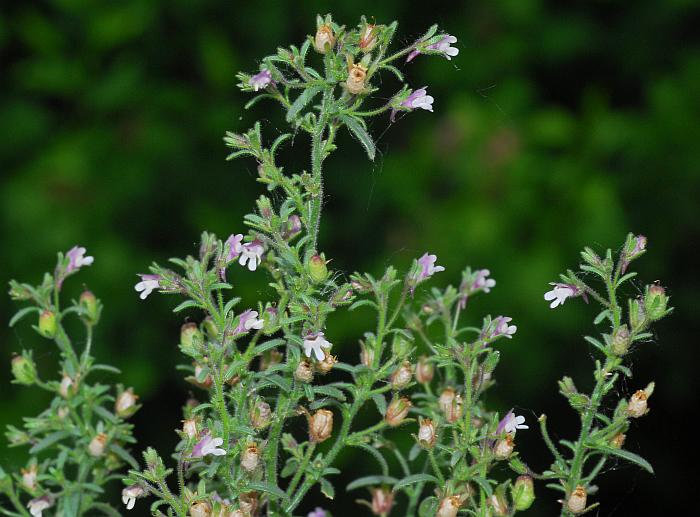Chaenorhinum minus (L.) Lange
Dwarf Snapdragon

Introduced
CC = *
CW = 5
MOC = 21
© SRTurner
Chaenorhinum minus (L.) LangeDwarf Snapdragon | |
 |
Introduced CC = * CW = 5 MOC = 21 |
© SRTurner |
|
Family - Plantaginaceae Habit - Taprooted annual forb. Stem - Ascending to erect, to 50 cm, moderately to densely glandular-hairy, often branched.
Leaves - Simple, entire, sessile or very short-petiolate, glandular pubescent. Lowest few opposite to sub-opposite, spatulate, purplish abaxially. Main leaves alternate, sub-acute, 0.5-1.5 cm long, 1-5 mm broad, purplish below, tapering at base to a short petiole.
Inflorescences - Terminal racemes, often appearing as solitary axillary flowers, the flower stalks 4-13 mm long at flowering, becoming elongated to 5-23 mm at fruiting, glandular-pubescent, each subtended by a leaflike, linear bract.
Flowers - Perfect, strongly zygomorphic. Calyces 2.0-3.5 mm long at flowering, becoming enlarged to 3.5-4.5 mm at fruiting, deeply 5-lobed nearly to the base, the lobes slightly unequal in length, linear to narrowly oblanceolate, rounded or bluntly pointed at the tip, moderately to densely glandular-hairy. Corollas 4.5-8.0 mm long, bilabiate, 5-lobed, glandular-hairy on surfaces, especially on the tube, the tube about as long as or slightly longer than the lobes, white to lavender or purple, the lower lip and throat white or with pale yellow markings, sometimes pale purplish- or pinkish-tinged, the remainder variously white to light purple, the tube with a well-developed, narrowly conic spur 1.7-2.8 mm long at the base (this positioned between the lower 2 calyx lobes), the throat not closed by the noticeably convex base of the lower lip, the upper lip 2-lobed and more or less straight, the lower lip with the 3 lobes rounded, more or less spreading. Fertile stamens 4, the filaments of 2 lengths, fused to base of corolla tube, not exserted. Filaments white, mostly glabrous but with glandular hairs at base, longest to 4 mm long. Anthers pale yellow to white, the anther sacs more or less spreading; staminodes absent. Style 1, 2 mm long, purple, not exserted, sparsely glandular pubescent at the base. Stigma capitate, unlobed. Ovary superior, glandular pubescent, green, 1 mm long, 2-locular.
Fruits - Capsules 3-6 mm long, broadly oblong-ovoid to globose, usually glandular-hairy on the outer surface, the 2 locules unequal in size, dehiscent by irregular pores at the tip, each locule with 1 pore. Seeds numerous, 0.5-0.8 mm long, oblong to oblong-ovate in profile, not flattened, the surface dark brown, with several longitudinal ridges, also with minute papillae.
Flowering - May - September. Habitat - Prairies, roadsides, railroads, disturbed areas. Origin - Native to Eurasia. Lookalikes - None. Other info. - This species occurs in widely scattered areas of Missouri. Its U.S. distribution is predominantly in the upper Midwest and New England. This small species is often overlooked because of its small size, however, the flowers are quite striking and interesting when examined in detail. C. minus is easy to ID in the field because of its distinctive flowers, small size, and glandular pubescent stems. It was first found in Missouri in 1946. Photographs taken of a plant found near Indian Creek, Washington County, MO, June 2019 (SRTurner). |